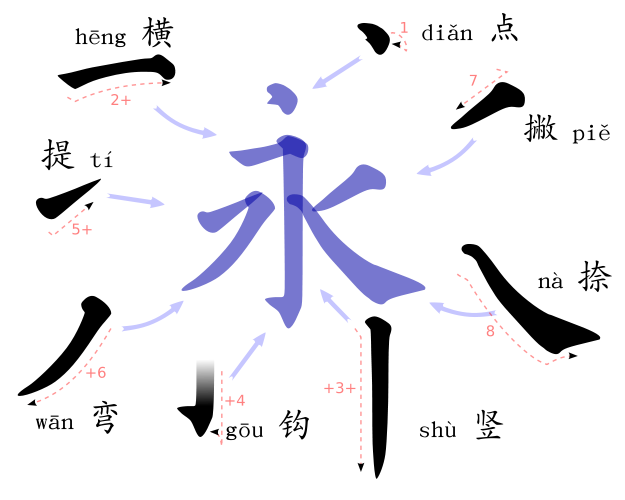Introduction to Chinese writing
Learn Chinese: Chinese writing
The writing unit of Chinese character or sinogram is the line. In Chinese writing, there are eight basic strokes:

These eight simple strokes can have many variants, 29 in all, the so-called "compound stroke". But it is not a good idea to learn them too early. You just need to know that these eight basic strokes may vary.
With these eight basic strokes and their variants, one can write a hundred or so basic Chinese characters called graphic components. Some graphic components are single words as 马 mǎ (horse), others are never found alone as the component 氵 for water, only with other components. By combining these components, one can create an infinite number of Chinese characters. The learning of graphic components may seem unnecessary and tedious to the beginner, but it then enables you to memorize Chinese characters much more easily.
Warning
You will often hear about "radical". The radical of a Chinese character is the graphical component that allows us to classify it and find it in a dictionary. Modern Chinese dictionaries list 214 radicals. To describe the composition of the Chinese character, it is better to speak of graphic component rather than radical. Indeed, a Chinese character has only one radical, but can be composed of several graphic components. On the other hand, some important graphics components are not listed as radicals. Finally many radicals are themselves built with several graphic components.
Writing rule
A Chinese character is written in an imaginary square. If the character is composed of several components, which is almost always the case, the components must not be too far apart and all must fit in the same square, otherwise they will be considered as different characters. For example, the character 好 is composed of two components. If we do not write the two in the same imaginary square, it reads: 女子.
When learning to write a Chinese character, it is imperative to respect the stroke order, that is to say the proper order and correct direction in writing strokes.
There are seven basic Chinese writing rules. You can see them on this page: Chinese writing rules. It should be noted that the vertical lines are always from top to bottom and the horizontal lines from left to right.
We learn to write Chinese characters on simple sheets like printer paper. A ballpoint pen is quite suitable for practice. We practice on grids provided for this purpose. The website chine-culture.com offers a tool for generating writing grids to practice with. In this online Chinese course you can download and print handwriting practice grids of each lesson.
The writing grids for this lesson and the example of filled out writing grid provided can be downloaded in the writing lesson of this sequence.
Background Colour
Font Face
Font Kerning
Font Size
Image Visibility
Letter Spacing
Line Height
Link Highlight
Paragraph Width
Text Alignment
Text Colour
